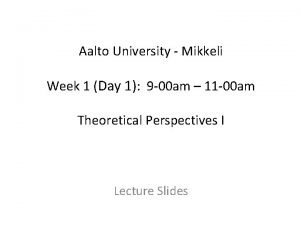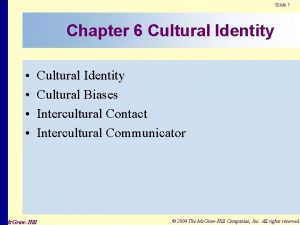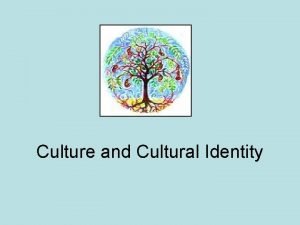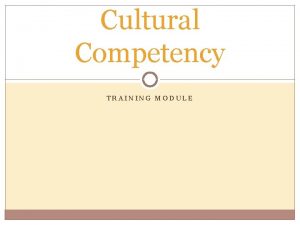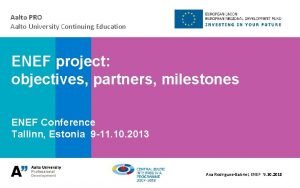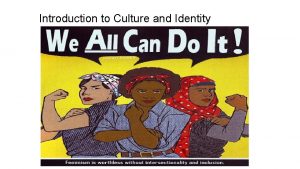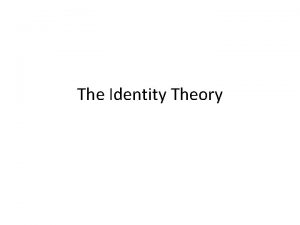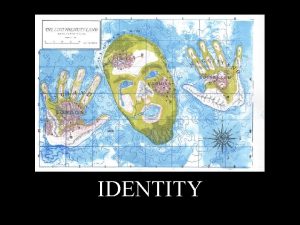CONSUMER IDENTITY PROJECTS Consumer Culture Theory Aalto University


























- Slides: 26

CONSUMER IDENTITY PROJECTS Consumer Culture Theory Aalto University Winter 2017

ASK YOURSELF • What is the article really about? • What ongoing, historical conversation is it a part of? • What questions does it ask? • What theory does it evoke? • What does it show? • What does it matter? What does it change?

CONSUMER RESEARCH CA. 1972 Managerial Marketing Dominant Discursive System Psychology, economics Elements of Consumer Research

PARADIGMATIC ORIENTATIONS IN CLASSIC CONSUMER RESEARCH Ontology: The rational decision making consumer Epistemology: Scientific prediction and control Axiology: Managerial

A DYADIC MODEL The Firm Exchange The Consumer

CONSUMER IDENTITY PROJECTS • CCT concerns the co-constitutive, co-productive ways in which consumers, working with marketer-generated materials forge a coherent, if diversified and often fragmented sense of self • Consumers are conceived of as identity makers. • Consumers actively rework and transform symbolic meanings encoded in advertisements, brands, retail settings, or material goods to manifest their particular personal and social circumstances and further their identity goals. • The key question driving this program of research is, what does it mean to be, in the full ontological sense of the term, a consumer? • The study of consumer identity projects meshes with consumer research’s more traditional interest in consumer goals and motives

CCT: A CONTRASTING ORIENTATION • Human beings realize themselves as historical socially constituted subjects via their interaction with the material world they constitute. • Attachment to objects as symbols of security, as expressions of selfconcept, and as signs of one's connection to or differentiation from other members of society is a usual and culturally universal function of consumption

ROMANTIC HUMANIST DISCOURSE IN EARLY CCT WORK 1975 -1985

PARADIGMATIC ORIENTATIONS Ontology: The cultured consumer Epistemology: Verstehen; Scientism Axiology: Antimanagerial; antilaboratory

THE CULTURED CONSUMER Individual Ludic Authentic Symbolizin g

MY FAVORITE THINGS: A CROSSCULTURAL INQUIRY INTO OBJECT ATTACHMENT, POSSESSIVENESS, AND SOCIAL LINKAGE

RQS • First, the analysis attempts to clarify the nature of attachment to favorite objects for the two groups of respondents. • Second, relationships between attachment to a specific favorite object and more general attachment phenomena are addressed. • The third research question involves cross-cultural comparisons of levels of favorite object attachment and the generalized possessiveness component of materialism. • Finally, how do three components of society, culture, age and gender structure and explain favorite object selection cross-culturally

FAVORITE THINGS EXAMPLES, DANISH STUDENTS My watch grandmas wedding ring Grandma’s pearl earrings Wedding ring cross Play station 3 Magneto Electric guitar Sideboard gift Bedouin bracelet Pinde – cuddly animal Self-assembled computer Ring from BF Necklace from F to M to self Odense Boldklub sports jersey High School Graduation cap Badminton Racket The Zippo Memories Pikorua – Maori pendant Old Omega seamaster watch Teddy bear International chess master certificate Inherited wood chest Music poster

POSITIONING • Developing a comparative frame • Making the exotic familiar • Defamiliarizing the everyday • Establishing individual and collective levels of analysis • Assessing the normative dimension of possession • Axiom: a universal dialectic of style through which three fundamental social processes are enacted: differentiation, comparison, and integration

METHODOLOGY SW USA Eastern Niger survey photos focus group Interpretation

KEY FINDINGS • Points of contrast • Points of similarity • Novel distinctions • Materialism, possession attachment, social linkage • Novel observations • Age and possessiveness • Gender and social linkage

MEANINGS • For roughly 60 percent of the American sample (n = 171) the reasons given reflected attachments based upon personal memories. The object was a favorite because it was a reminder of a friend or family member, a vacation trip, or an event in the respondent's past. • For 6 percent of the U. S. sample {n = 18), the object was a favorite because it reminded the respondent of the person who had made it, typically as a gift. • Some U. S. respondents chose functional (rather than display) objects such as chairs or clocks. Nevertheless, the reason given for these attachments typically derives from a shared history.

CHERISHED POSSESSIONS

OBJECT ATTACHMENT • Mean of 3. 72 for the Nigeriens (raw s. d. = 0. 72) and 4. 28 for the Southwest Americans (raw s. d. = 1. 35). • A t-test of the difference between these standardized group means for attachment to favorite object was statistically significant (t = 3. 52, df = 344, p < 0. 0001). • Thus, on average, the U. S. sample is more strongly attached to their favorite objects than is the Nigerien sample. • Those U. S. respondents who indicated either a personal or maker-based reason for favorite object attachment scored higher on the person attachment scale than did those with an object-based reason for attachment (t = 2. 29, p = 0. 023).

POSSESSIVENESS • Survey findings suggest that Americans are substantially more materialistically possessive than are the Nigeriens. • The major consumption goal of Zinderois elicited in surveys (Crow and Henderson 1979; Republique du Niger 1985) remains nutritional self-sufficiency. • In contrast to the American consumers, Zinder's consumers have not yet been taught to consume and how much to consume "the good life"

OBJECT ATTACHMENT NIGER • 17 percent of the Nigerien responses indicated that part of the value of favored possessions derived from their exchange value, that is from their convertibility to cash. • Just over 19 percent indicated that the object's spiritual and/or magical efficacy was responsible for the person's attachment to it. • 8 percent indicated that the object's prestige value was the reason for its selection as a favorite object. • 16 percent cited the object’s auto erotic qualities as a reason for selecting the favorite object. • Nigerien informants were quick to qualify remarks that might indicate great attachment to objects

GENDER • Women and linkage value • U. S. women are more likely than men to choose handicrafts, antiques, and representational items such as photographs of family members. • In Niger, items usually given to brides upon marriage and commonly employed in competitive displays between women on major religious holidays or during household (32 & 15 %). • life crisis rituals (baptisms and marriages). • Men and authority value • Religious books, including copies of the Koran were named by 22 percent of Nigerien informants, and exclusively by men.

AGE AND POSSESSIVENESS • On a seven-point scale probing degree of liking of the favorite object. The mean on this question was high {x = 5. 8. s. d. = 1. 4), as should be expected. • Mean responses vary by age group. Favorite object liking increases by age group. • Favorite object liking increases with age until 65, then declines sharply (one way ANOVA F = 2. 6, p = 0. 02). • Between the five age groups from 18 -24 through 55 -64, as age increases, liking of the favorite object increases. • However, in moving from 55 -64 into the 65 and older age group, liking of the favorite object declines to its lowest level.

AGE, GENDER AND INNOVATION

GENDER AND SOCIAL LINKAGE • Women frequently chose items made for or given to them by others, antiques or heirlooms that tie them to previous generations, and representational items (e. g. , photos) depicting their children, spouses, and grandchildren. • But in the Zinder sample, the relation between gender and social linkage (r = -0. 3 l, p = 0. 02), indicates greater density of men's social networks. • This finding may be explained by bias in scale construction for social linkage and the gender roles specified in this Moslem culture. In Niger, men's social networks tend to be more extended than women's, since they have greater freedom of movement. Women's networks are comprised of stronger, more private ties.

FUTURE RESEARCH • Social construction of these personal meanings • to explore how preferences for favorite objects change both within the lifespan of individuals • to explore how preference patterns change, particularly in developing economies • the reasons why particular objects become cultural icons and not others. • Disposition of cherished possessions
 Consumer identity projects
Consumer identity projects Food web vs food chain
Food web vs food chain Aalto university school of engineering
Aalto university school of engineering Aalto university mikkeli
Aalto university mikkeli Aalto university mikkeli
Aalto university mikkeli Cct theory
Cct theory What is consumer culture theory
What is consumer culture theory Examples of identities of a person
Examples of identities of a person Why is culture identity important
Why is culture identity important Concept of identity
Concept of identity Cultural competency training modules
Cultural competency training modules Ethnocentrism examples
Ethnocentrism examples Individual culture traits combine to form culture patterns.
Individual culture traits combine to form culture patterns. Batch culture vs continuous culture
Batch culture vs continuous culture Continuous culture and batch culture
Continuous culture and batch culture Individualistic culture definition
Individualistic culture definition Difference between american and indian culture
Difference between american and indian culture Stab and stroke culture
Stab and stroke culture Folk culture and popular culture venn diagram
Folk culture and popular culture venn diagram Vocational subculture
Vocational subculture Folk cultures are spread primarily by
Folk cultures are spread primarily by Anerobic media
Anerobic media Homework due today
Homework due today Inert organizational culture
Inert organizational culture Carpet culture method
Carpet culture method Lawn culture method
Lawn culture method Quality culture vs traditional culture
Quality culture vs traditional culture



